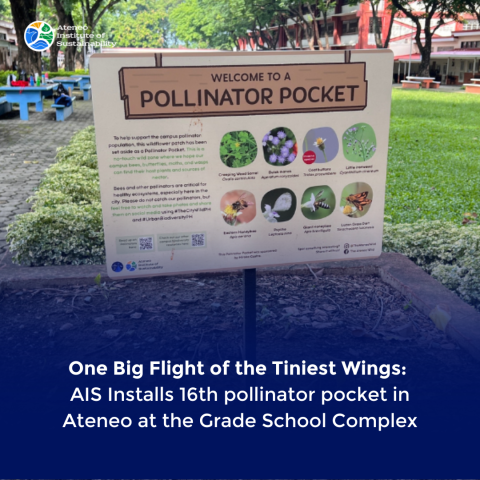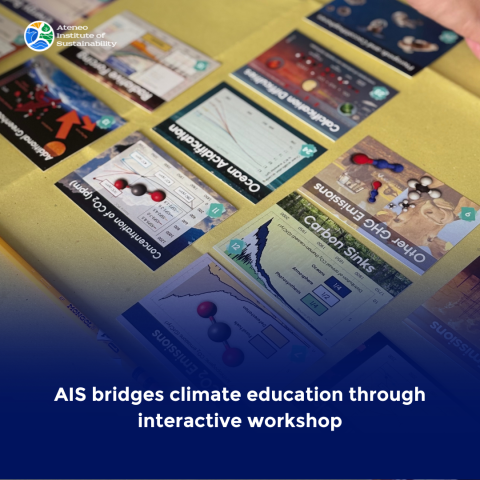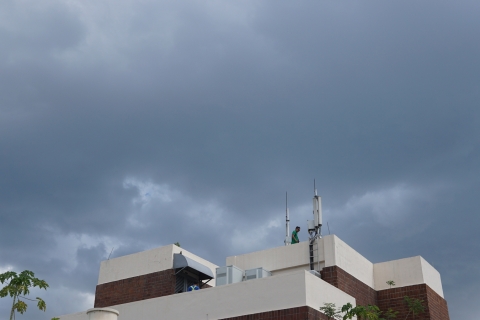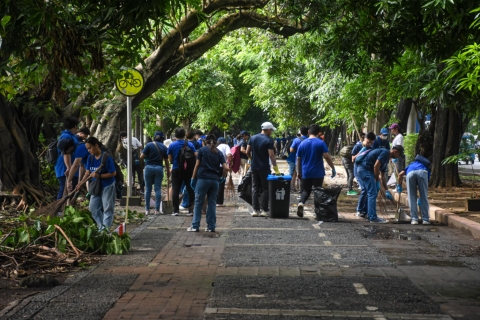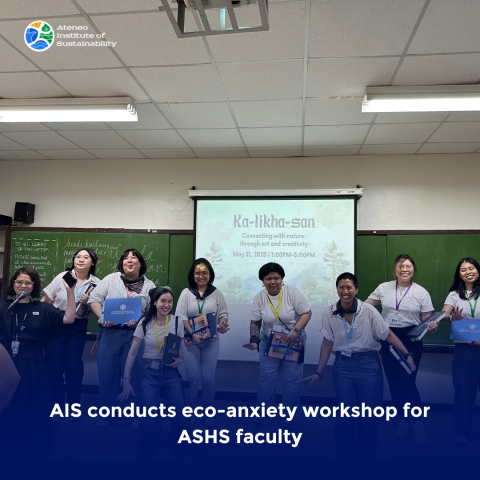Bringing energy transition and interdisciplinary collaboration into light in MCR-Ateneo Climate Research webinar
24 Jun 2024 | John Paul I Blando and Ivy Geraldine Ferrer
On 08 May 2024, the My Climate Risk – Ateneo de Manila University (MCR-Ateneo) Regional Hub, which is hosted by the Ateneo Institute of Sustainability, organized a webinar titled “Efficient Energy Transition, Science, and Stakeholder Engagement: The Case of Philippine Electricity Policy.” My Climate Risk is a lighthouse activity of the World Climate Research Programme which aims to develop and mainstream a bottom-up approach to regional climate risk, and has a mycorrhizal network of hubs that span all continents except Antarctica.
The webinar was co-hosted by the Development Academy of the Philippines (DAP) and featured Dr Majah-Leah V Ravago, the 10th President of DAP and Associate Professor at the Department of Economics of Ateneo de Manila University, as resource speaker. She highlighted the importance of shifting towards sustainable practices, particularly the adoption of clean energy sources, which hinge on the centrality of electricity. To achieve this transition, interdisciplinary approaches from different sectors, such as the government, private sector, and academia, must be taken into account in crafting policy reforms that promote the efficient and sustainable use of renewable energy (RE) sources.
Dr Charlotte Kendra Gotangco Gonzales, Director of the Ateneo Institute of Sustainability and Focal Point of the MCR-ADMU Hub, delivered the Opening Remarks, detailing the mission and vision of My Climate Risk. Contextualizing the role of MCR in the energy sector, Dr Gonzales mentioned the crucial role of having a systems perspective to cope with the energy crisis we currently experience. Dr Ma Assunta C Cuyegkeng, Executive Director at Lily Gokongwei Ngochua Leadership Academy and a Collaborator of the Hub, concluded the webinar by expressing her appreciation of Dr Ravago’s talk, which centered on the importance of policy-making and engaging stakeholders in addressing climate and energy risks. The session was moderated by Ms Jean Jardeleza Mijares, Program Manager for Climate and Disaster Resilience at the Ateneo Institute of Sustainability.
To start the plenary session, Dr Ravago explained the concept of the energy transition, and discussed the differences between the approaches of developed and developing countries in terms of income levels, preferences, and energy market structures and infrastructure. Here, she highlighted the nuanced priorities of the two; developed countries may choose to take leadership positions on climate mitigation, while developing countries like the Philippines may tend to prioritize improving living standards. For the latter group, making efficient and sustainable energy transitions may then seem like a burden. This gives an overview of the status of the country’s energy transition from fossil-based to RE sources.
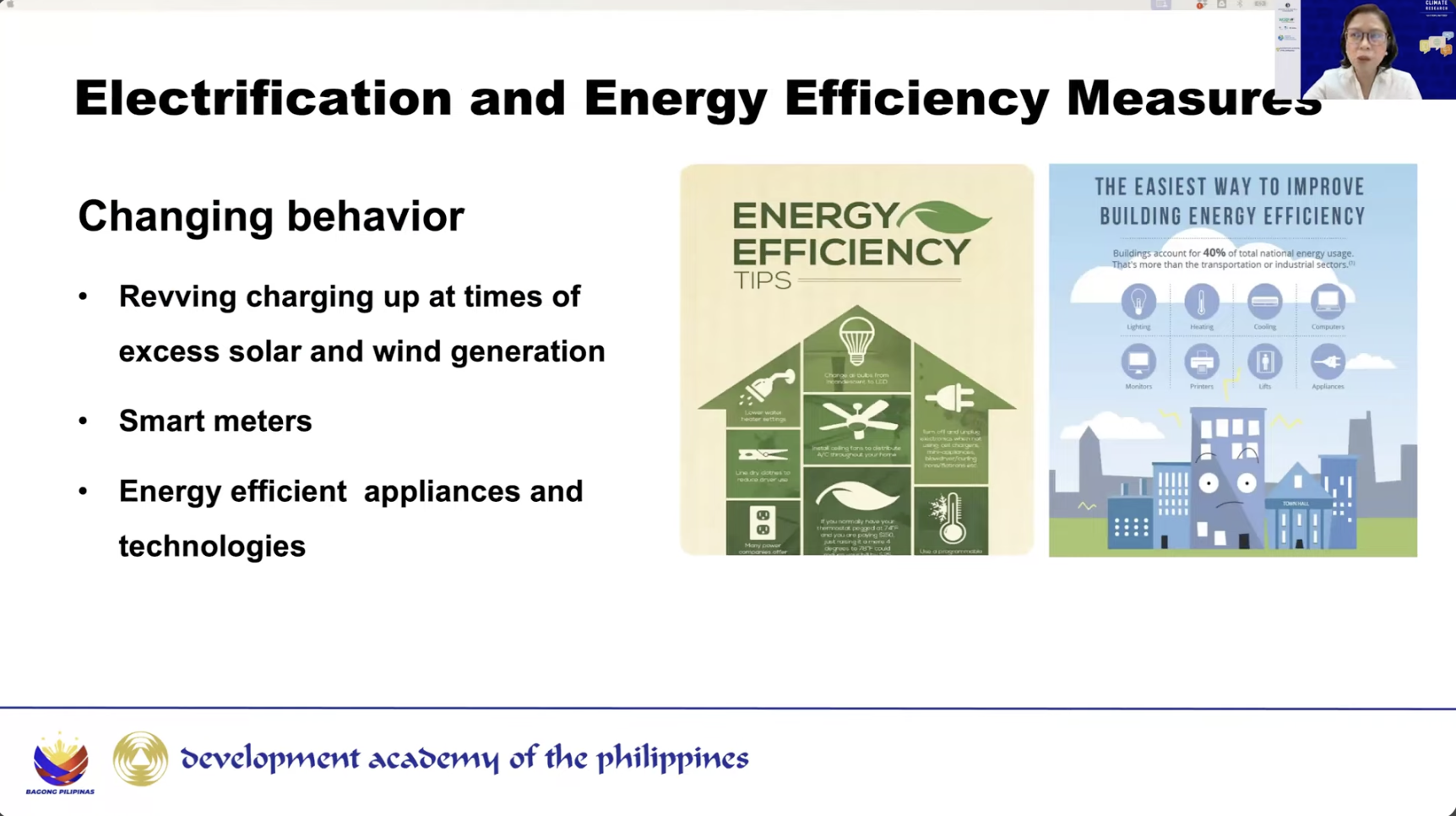
Along with the clean energy transition, Dr Ravago discussed a shift towards “electricity-only” resources, hence the need for electrification. With growing electricity demand, a reevaluation of consumption patterns and infrastructure must be done to facilitate this transition. For instance, the rise of electric vehicles (EVs) poses new electricity consumption patterns as it is projected to reshape peak consumption periods to midnight due to charging. This creates both challenges and opportunities for energy management, prompting a reimagining of the role of energy efficiency.
Dr Ravago pointed out the significance of energy efficiency as it maximizes the efficacy of RE adoption, serving as the backbone of this transition process. In light of this, the growing demand for renewables comes with the need for energy-efficient solutions across all sectors. These solutions are not solely focused on behavioral changes, such as unplugging appliances, but also include investments in smart meters and energy-efficient technologies to capitalize on surplus energy from solar and wind sources. Delving deeper into this topic, she counseled, especially to the student participants of the event, that this transition would also necessitate studies on the optimal nature of its stages and timing of electrification. Giving more context on the relationship between the status of the different countries and their energy transitions, she underscored the disparities in RE penetration between high-income and low- to middle-income countries, citing a faster RE penetration in the former than in the latter. While she acknowledged a global increase in the trend of RE transition, Dr Ravago noted that many developing nations still face challenges scaling up RE in their energy mix. Relating this to the business side, one factor that can be attributed to this is the unequal investments; to be able to transition to RE, the expansion of infrastructure, particularly transmission systems, must also be considered to facilitate the delivery of energy to consumers.
In the Philippine context, the energy transition presents both unique challenges and opportunities. Despite goals to increase the share of RE in the energy mix to 35% by 2030 and 50% by 2040, the country still grapples with a heavy reliance on coal, which covers 58% of its generation mix as of 2022. This is higher compared to the 22% that RE provides in the mix, which is not enough to electrify the whole nation. Backing up this data, Dr Ravago cited historical trends that revealed a complex interplay between different energy sources, with coal often dominating the generation mix due to factors such as availability and infrastructure complaints. For instance, natural gas once dominated the generation mix in Luzon with the operation of the Malampaya Gas Field. On the other hand, most geothermal plants in the country are found in Visayas, while hydropower plants dominate the generation mix in Mindanao. However, these energy sources have gradually decreased as the years passed, prompting a heavy reliance on non-RE sources such as coal.
Aside from this, Dr Ravago cited other factors contributing to the slow penetration of RE in the Philippines. First are the regulatory restrictions, such as the 60:40 ownership rule that was only liberalized last year, and the amount of permits that may take a generation plant 1.5 years to secure before they can start with construction. Second are investor preferences for subsidies, and lastly, challenges in infrastructure development. Addressing these barriers requires a multifaceted approach, encompassing reforms in the power sector infrastructure, easing regulatory burdens, and promoting structural changes to mainstream RE. Some efforts to expand renewables, such as using coal as the base load and determining the most efficient and low-cost generation mix of RE, must be complemented by initiatives to enhance energy access and affordability, ensuring that all citizens have reliable electricity. Citing systemic inefficiencies and over-taxation as the root causes of high electricity prices in the Philippines, Dr Ravago emphasized the need for comprehensive reforms to improve both affordability and accessibility of electricity.
As the Philippines is in the low renewable penetration stage, it is still well-positioned to implement the reforms necessary for the energy transition. Recent developments, including a moratorium on new coal-fired power plants and the liberalization of the 60:40 rule in the RE sector, signal a growing momentum towards cleaner energy sources. This, she noted, requires interdisciplinary efforts and sustained engagement with different stakeholders.
In the second part of her talk, Dr Ravago presented some of the projects that she was involved in, highlighting crucial components of engaging with stakeholders such as research, policy development and providing advisory capacities, capacity building, and communication. Doing interdisciplinary research, such as in economics and science, is essential to engaging with stakeholders. She also noted that consultations with key stakeholders should be done, as was the case in her engagements with the National Economic and Development Authority, the Department of Energy, the Philippine Electricity Market Corporation, and the Energy Regulatory Commission. Here, she highlighted the role of academia as a neutral entity between the government and private sector, leading open discussions with research-backed data. These data, according to her, must be communicated while taking into account the different contexts of the audience to effectively relay information, which can be in the form of journal articles, newsletters, and social media posts.
In closing, Dr Ravago summarized that engaging with stakeholders in energy policy and development programs mainly focuses on the importance of interdisciplinary collaboration, sustained advocacy, and the cultivation of champions at the highest policy-making levels. Research, to become great, should be communicated with people outside the scientific community and in engaging with policymakers and other stakeholders. It is also important to consider the key players involved as well as the timing to have a more open and productive discussion. By leveraging evidence-based research, interdisciplinary collaboration, and strategic engagement, academia can contribute to shaping a more sustainable energy future for the Philippines and beyond.
The session was attended by participants from the Philippines, with international attendees from Australia, Bangladesh, Côte d'Ivoire, Hong Kong SAR, Namibia, Nigeria, Pakistan, Rwanda, and Sweden. This webinar was the third and final session in the 2024 iteration of “Climate Research ‘As If People Mattered’,” the name of which comes from the article “Small is beautiful: climate change science as if people mattered,” written by Dr Regina R Rodrigues and Dr Theodore Shepherd, Co-Chairs of the Scientific Steering Group of the My Climate Risk lighthouse activity. The series occurred from April to May 2024. Replays and highlights of the webinar series are available in the following page.





